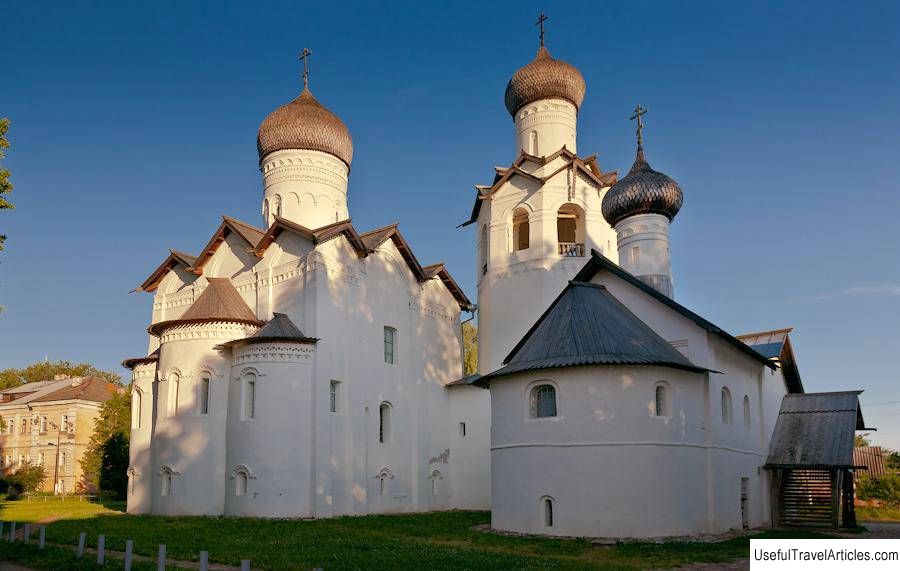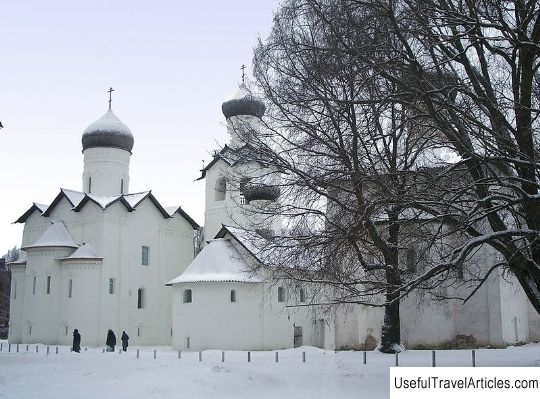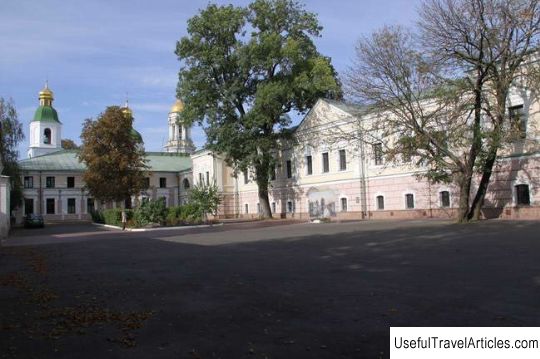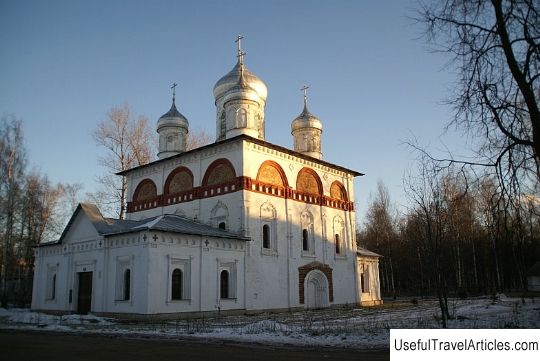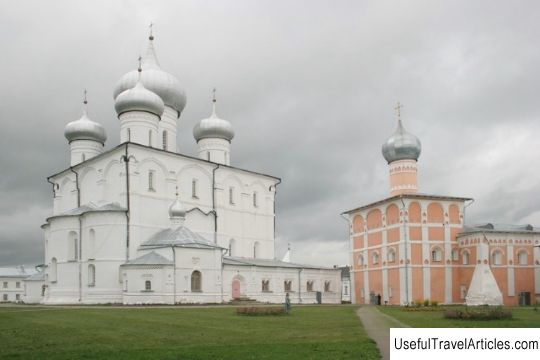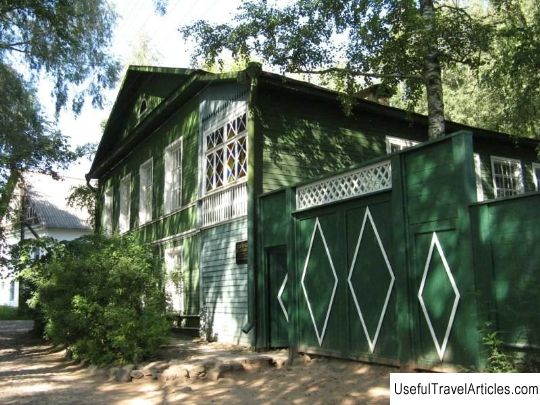Spaso-Preobrazhensky monastery description and photos - Russia - North-West: Staraya Russa
Rating: 8,9/10 (1432 votes) Spaso-Preobrazhensky monastery description and photos - Russia - North-West: Staraya Russa. Detailed information about the attraction. Description, photos and a map showing the nearest significant objects. Photo and descriptionThe small picturesque Spaso-Preobrazhensky monastery in Staraya Russa traces its history back to the 12th century. Three churches, built in the 1630s, and a unique pillar-shaped bell tower have survived here. Now the buildings of the monastery house a museum of local lore, which has an interesting archaeological collection and a rich gallery of Soviet painting. History of the monasteryThe foundation of the monastery is associated with the name of the holy Novgorod bishop Martyrius (Rushanin). In Staraya Russa, it is believed that this saint was originally from here and he founded a monastery in his homeland. It was under him in 1191 that the first Transfiguration Church appeared here, and in 1196 it was replaced by a stone one. The monastery was located in the bend of the river, so this place was called an "island", but the monastery itself was most often called "a monastery on the posad": it was not in the fortified center of the city, but in the distance, in a residential settlement - and became a small wooden fortress that protected this posad. However, the chronicle mainly includes stories of defeats and devastations: the monastery was burnt down by the Lithuanians in 1234, ravaged in 1612 by the Swedes, and was almost rebuilt in the first third of the 17th century. Then a bell tower and two more stone churches appeared here, in addition to the main cathedral. A hundred years later, a stone abbot building was built here. Until 1764, the monastery was not the poorest, but most of its land was confiscated after the secular reform of Catherine II, but it remained among the regular monasteries. In the 19th century, the monastery flourished: a new temple appeared, a fence with a holy gate, increased maintenance of the monastery. In the first years after the revolution, the former Ryazan bishop Dimitri (Sperovsky) became the abbot of the monastery. He was an educated person, an art critic and author of a study on ancient Russian iconostases, and, at the same time, a man of extreme right-wing views, a monarchist and chairman of the Ryazan Union of the Russian People. Among the inhabitants of Staraya Russa, he enjoyed love. In 1922, he saved part of the monastery's treasures from confiscation by organizing a collection among the population in favor of the starving. In the end, the monastery was closed. Some of the buildings were demolished, some were rebuilt, moreover, it was significantly damaged during the war. In the post-war years, the buildings were restored and transferred to the local history museum. The museum itself in Staraya Russa was founded in 1920 and occupied the building of the local council. Valuables from ruined estates of the Novgorod province got here. The museum was given the building of the Resurrection Cathedral (now it has been returned to believers), Dostoevsky's house and other city buildings. Since 1963, the Museum of Local Lore has become a branch of the Novgorod Museum-Reserve, its main exposition is located in the former Spaso-Preobrazhensky Monastery. Savior Transfiguration Cathedral Dilapidated original the cathedral was dismantled and rebuilt in 1442. It was badly damaged during the Time of Troubles, and was rebuilt in 1628-1630. In the temple at the bottom of the walls, fragments of the original painting of the 12th century have been preserved. The cathedral was rebuilt in the 17th-19th centuries, the Soviet restoration returned it to the look of the 17th century. Since 1976, the museum's archaeological collection has been located here. In Staraya Russa, excavations were carried out by archaeologists E. Toropova, A. Medvedev and V. Mironova. Research in Staraya Russa continues, and every year at the end of the archaeological season, in the fall, a conference devoted to its results is held here. Staraya Russa, like Novgorod, was lucky with archeology. The structure of the soil and the climate made it possible to preserve many unique items: wood and leather products, fabrics, and most importantly - birch bark letters. The museum has its own letters and copies of the original Novgorod ones, which colorfully tell about the life of medieval Russia. The hall of the museum is not an archaeological, but a very interesting modern exhibit is an artistic map of Staraya Russa with images of all its most important sights. The rest of the exposition tells about the history of the Spaso-Preobrazhensky Monastery and the fate of the city during the war, in addition, the museum holds temporary exhibitions from its rich funds. The bell tower of the cathedral was built in 1630. This is a rather rare type of building that combines a temple and a bell tower, such structures were called “those like the bells”. This is a four-tiered round tower with a bell tower at the top and a temple inside. However, by the 18th century, the monastery was leasing the lower tier as a warehouse. In 1818, the bell tower was rebuilt in the taste of modern times, and the Soviet post-war restoration returned it to the look of the 17th century. The bells were removed during the Soviet era and have not survived to this day. Now you can climb the bell tower - there is an observation deck with a magnificent view of Staraya Russa. Churches and an art gallery The brick Christmas church was built on the site of the wooden one in 1630. In 1892, she was transferred to a theological school and became Cyril and Methodius. This is a small one-domed church with a gable roof, now it is run by the museum. The third surviving church of the monastery is the Sretenskaya refectory, also erected in 1630, in the same way brick and one-domed. It suffered more than others during the war, and was rebuilt almost from scratch during Soviet times. Its decoration is a high stone porch. Now, this church houses perhaps the most interesting part of the museum - the art gallery. Unfortunately, the very first collection of paintings from the surrounding estates, dating back to the museum in 1922, was lost during the Great Patriotic War. Now the main part of the exhibition is the work of the artist V.S. Svarog (Korochkina), a native of Staraya Russa. Before the revolution, he was engaged in artistic illustration, was close friends with the son of Ilya Repin - Yuri. He accepted the revolution, painted a lot on revolutionary themes, created portraits of political figures - K. Marx, V. Lenin, I. Stalin, and others. However, in addition to politics, he was fond of music, performed operatic roles and painted pictures on musical themes. There are more than 200 of his paintings in Staraya Russa. In addition to his works, the gallery displays paintings by local artists: Ushakov, Lokotkov, Pevzner and others. A whole room is dedicated to the works of the sculptor N. Tomsky. Old Russian Cathedral and Old Russian Icon The biggest shrine of Staraya Russa is the Old Russian icon of the Virgin. It was originally kept in the Transfiguration Cathedral. Two different legends tell about her appearance. She appeared in the city either in the 15th or 16th century, and has either Greek or Russian origin. One way or another, in 1570 she ended up in Tikhvin - there was an epidemic there, and the inhabitants asked to send a miraculous shrine to them. And they never gave it away, although in return they sent a list from their shrine - the Tikhvin icon. Already in 1805 the Rushans requested the icon back. They were refused. Throughout the 19th century, they besieged the church and secular authorities with petitions, until in 1888 the icon was returned to the monastery. At first she was placed in the Transfiguration Cathedral, but four years later, by the 700th anniversary of the monastery, a new one was built for her, consecrated exactly in honor of this icon. This new cathedral is now also associated with the memory of St. John of Kronstadt - a famous priest consecrated one of its chapels. Unfortunately, now this temple is practically unrecognizable. In the post-war years, the domes were dismantled, the roof was redesigned and now it is occupied by a children's sports school. Nothing has survived from its interior decoration, and the revered icon itself is now in the church of St. George in Staraya Russa. Interesting facts
Notes
        Topic: Spaso-Preobrazhensky monastery description and photos - Russia - North-West: Staraya Russa. |
